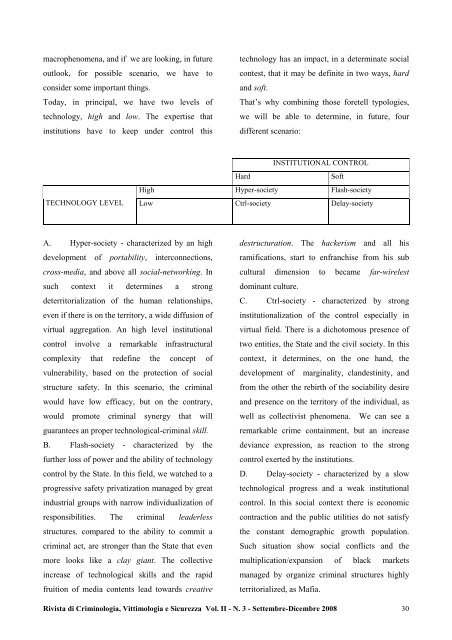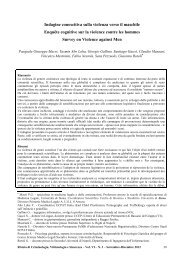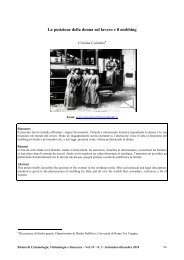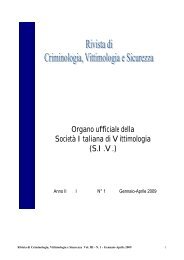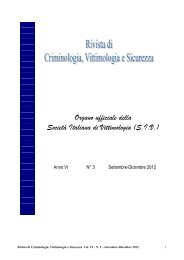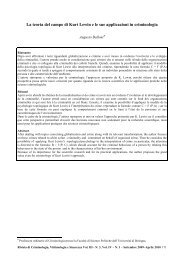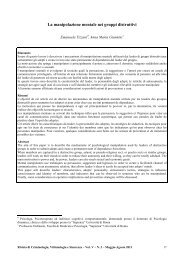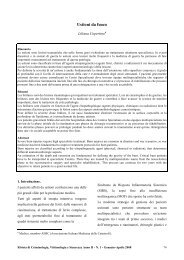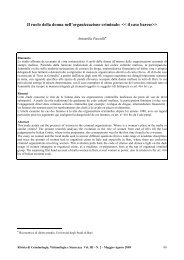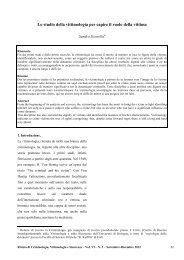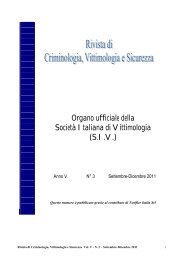Anno 2, Numero 3, Settembre-Dicembre 2008 - Vittimologia
Anno 2, Numero 3, Settembre-Dicembre 2008 - Vittimologia
Anno 2, Numero 3, Settembre-Dicembre 2008 - Vittimologia
You also want an ePaper? Increase the reach of your titles
YUMPU automatically turns print PDFs into web optimized ePapers that Google loves.
macrophenomena, and if we are looking, in future<br />
outlook, for possible scenario, we have to<br />
consider some important things.<br />
Today, in principal, we have two levels of<br />
technology, high and low. The expertise that<br />
institutions have to keep under control this<br />
technology has an impact, in a determinate social<br />
contest, that it may be definite in two ways, hard<br />
and soft.<br />
That’s why combining those foretell typologies,<br />
we will be able to determine, in future, four<br />
different scenario:<br />
INSTITUTIONAL CONTROL<br />
Hard Soft<br />
High Hyper-society Flash-society<br />
TECHNOLOGY LEVEL Low Ctrl-society Delay-society<br />
A. Hyper-society - characterized by an high<br />
development of portability, interconnections,<br />
cross-media, and above all social-networking. In<br />
such context it determines a strong<br />
deterritorialization of the human relationships,<br />
even if there is on the territory, a wide diffusion of<br />
virtual aggregation. An high level institutional<br />
control involve a remarkable infrastructural<br />
complexity that redefine the concept of<br />
vulnerability, based on the protection of social<br />
structure safety. In this scenario, the criminal<br />
would have low efficacy, but on the contrary,<br />
would promote criminal synergy that will<br />
guarantees an proper technological-criminal skill.<br />
B. Flash-society - characterized by the<br />
further loss of power and the ability of technology<br />
control by the State. In this field, we watched to a<br />
progressive safety privatization managed by great<br />
industrial groups with narrow individualization of<br />
responsibilities. The criminal leaderless<br />
structures, compared to the ability to commit a<br />
criminal act, are stronger than the State that even<br />
more looks like a clay giant. The collective<br />
increase of technological skills and the rapid<br />
fruition of media contents lead towards creative<br />
destructuration. The hackerism and all his<br />
ramifications, start to enfranchise from his sub<br />
cultural dimension to became far-wirelest<br />
dominant culture.<br />
C. Ctrl-society - characterized by strong<br />
institutionalization of the control especially in<br />
virtual field. There is a dichotomous presence of<br />
two entities, the State and the civil society. In this<br />
context, it determines, on the one hand, the<br />
development of marginality, clandestinity, and<br />
from the other the rebirth of the sociability desire<br />
and presence on the territory of the individual, as<br />
well as collectivist phenomena. We can see a<br />
remarkable crime containment, but an increase<br />
deviance expression, as reaction to the strong<br />
control exerted by the institutions.<br />
D. Delay-society - characterized by a slow<br />
technological progress and a weak institutional<br />
control. In this social context there is economic<br />
contraction and the public utilities do not satisfy<br />
the constant demographic growth population.<br />
Such situation show social conflicts and the<br />
multiplication/expansion of black markets<br />
managed by organize criminal structures highly<br />
territorialized, as Mafia.<br />
Rivista di Criminologia, <strong>Vittimologia</strong> e Sicurezza Vol. II - N. 3 - <strong>Settembre</strong>-<strong>Dicembre</strong> <strong>2008</strong> 30


